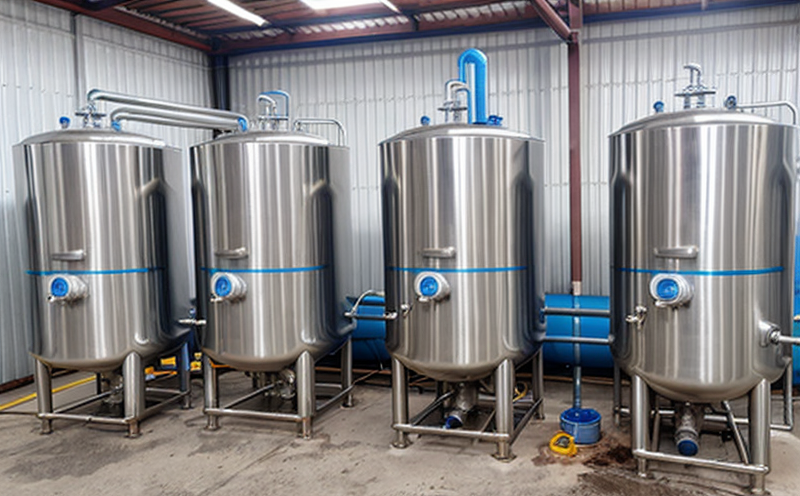ISO 11905-1 Total Nitrogen Test in Cooling Water
The ISO 11905-1 standard, known as the “Determination of total nitrogen in water,” provides a robust methodology for quantifying total nitrogen content in various types of aqueous solutions. This service focuses on implementing this standard specifically within cooling water systems, which are critical components in industrial facilities such as power plants, refineries, and manufacturing units.
Cooling water is a vital resource that helps regulate temperature in equipment and processes by transferring heat away from the system. However, the presence of total nitrogen can lead to scaling, corrosion, and biofilm formation, all of which negatively impact the efficiency and lifespan of cooling systems. Therefore, precise measurement of total nitrogen content becomes essential for maintaining optimal operating conditions.
The ISO 11905-1 method involves several steps including sample collection, preparation, digestion, and analysis using a continuous flow analyzer (CFA). The standard specifies detailed procedures to ensure accurate and reliable results, which are crucial for compliance with environmental regulations. By adhering strictly to the outlined protocol, laboratories can provide trustworthy data that helps operators make informed decisions regarding water treatment processes.
The testing procedure begins by collecting representative samples from the cooling system according to predefined guidelines. After proper preparation, these samples undergo digestion at high temperatures under controlled conditions. Following this step, they are analyzed using a continuous flow analyzer equipped with appropriate reagents and calibration standards provided in the ISO document.
Accurate measurement of total nitrogen content allows for effective management strategies aimed at minimizing its detrimental effects on equipment performance while ensuring sustainable use of natural resources. Compliance with international standards like ISO 11905-1 ensures consistency across different locations, enhancing trust among stakeholders involved in water quality control.
To summarize, the implementation of the ISO 11905-1 standard offers a reliable approach for determining total nitrogen levels in cooling waters. This service not only fulfills regulatory requirements but also supports continuous improvement efforts towards more sustainable practices within industrial settings.
Industry Applications
| Industry Sector | Potential Impact of Total Nitrogen in Cooling Water |
|---|---|
| Power Generation | Reduces thermal efficiency and increases maintenance costs. |
| Oil & Gas Refining | Potential for fouling of heat exchangers leading to reduced production capacity. |
| Pharmaceutical Manufacturing | Risk of contamination affecting product quality and safety. |
- Facilitates compliance with stringent environmental regulations.
- Aids in optimizing water usage efficiency through better understanding of contaminant levels.
- Supports decision-making regarding necessary treatments to enhance system performance.
Quality and Reliability Assurance
The accuracy and precision of total nitrogen measurements in cooling water are paramount for ensuring reliable operation of industrial facilities. By leveraging the ISO 11905-1 standard, we can guarantee that all analytical results meet stringent quality assurance criteria set forth by industry best practices.
Our team adheres meticulously to each step of the testing process outlined in the ISO document, from sample collection and preparation through digestion and final analysis. This ensures consistency across multiple tests conducted over time, allowing for accurate trending capabilities essential for identifying trends or anomalies indicative of potential issues within cooling systems.
The continuous flow analyzer (CFA) utilized in our lab is calibrated regularly against certified reference materials traceable to international standards such as ISO 17025. This calibration ensures that all analytical results are comparable and reproducible, thereby providing confidence not only among internal personnel but also with external auditors or clients.
In conclusion, rigorous adherence to the ISO 11905-1 standard enhances overall reliability by minimizing variability in testing outcomes, supporting sustainable operations, and ultimately contributing to long-term success for our clients.
Competitive Advantage and Market Impact
- Provides a competitive edge through superior data integrity and reliability.
- Enhances reputation as a trusted partner capable of delivering consistent results under demanding conditions.
- Aids in maintaining compliance with increasingly stringent environmental regulations, thus reducing risk exposure for clients.
- Promotes sustainable practices by helping customers identify areas where water conservation initiatives could be implemented effectively.
- Supports continuous improvement efforts aimed at optimizing resource utilization rates within industrial settings.
- Fosters innovation through deeper insights into contaminant behavior patterns, enabling development of more effective treatment methods.





